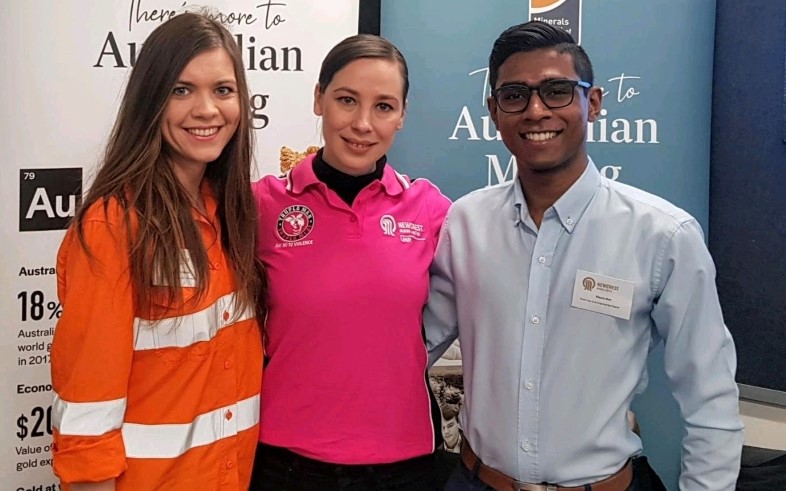High school stars at Swinburne published in international space journal

Visura Lokuge Don (right) is now working as a geotechnical engineer at Newcrest Mining since working on the journal article
In summary
- Research conducted by a group of high school students with Swinburne’s Centre for Astrophysics and Supercomputing (CAS) has been published in the journal, Galaxies
- The article was written by high school work experience students Visura Lokuge Don, Lochlan Bull and Kazuki Kuhlmann, alongside Professor Alister Graham and undergraduate scholarship student Katherine Kenyon
- The students collaborated with experts as part of a long-running program that supports the next generation
Research conducted by high school and undergraduate students at Swinburne’s Centre for Astrophysics and Supercomputing (CAS) has been published in the journal, Galaxies.
The article – ‘History of Astronomy in Australia: Big-Impact Astronomy from World War II until the Lunar Landing (1945–1969)’ – was written by high school work experience students Visura Lokuge Don, Lochlan Bull and Kazuki Kuhlmann, along with Professor Alister Graham and undergraduate scholarship student Katherine Kenyon.
CAS has welcomed Year 10 work experience students for over a decade. During their time at Swinburne, students are partnered with an astronomer and work on a specific research project. However, 'exceedingly few high school students perform research that forms the basis of a refereed journal article,’ says Professor Graham.
'The project would not have happened if it was not for the detective work of the students, which, according to Professor Graham, involved painstakingly going through decades of significant astronomy publications that had become available online for the first time.
High achievers
Visura Lokuge Don wanted to do his work experience with CAS due to his passion for astronomy and was drawn to the ‘idea of gaining an understanding of the unknown – on a larger scale’.
When he discovered that he had the opportunity to work closely with experts in astrophysics and supercomputing, Visura was ‘ecstatic’. He found that despite their busy schedules, they always made time to chat.
‘Being involved in this project was such a phenomenal prospect'.
Katherine Kenyon co-authored another journal article during her work experience program in 2011. She says she always found outer space ‘fascinating’ and ‘really enjoyed getting a taste of what research could be’.
‘A lot of people think of places like NASA when you talk about space and astronomy research, and they forget that a lot happens here in Australia too!’
Supporting young minds
The article published in Galaxies identifies the most significant Australian-led astronomy conducted after World War II until the lunar landing. In addition to reporting on solar outbursts, pulsars, black holes and the lunar landing, it mentions the astronomers involved in Australia’s biggest astronomical advances and discoveries from 1945 to 1969. Many pioneering women in science and World War II stories are identified.
Throughout the process, the students were included in meetings with other researchers and had the opportunity to network and build relationships.
‘It felt really cool to be a part of it and inspired me to lean more towards research as a career pathway. I learnt a lot about independence, both in a work environment and personally,’ says Katherine, who is currently completing a PhD in neuroscience.
Visura is now completing his masters and working as a graduate geotechnical engineer. He says that he has applied the academic and soft skills he learnt at Swinburne throughout his studies and beyond.
‘It was great to have one of my first paid employment experiences listed as Swinburne’s Centre for Supercomputing and Astrophysics on my resume. No disrespect to the more conventional work experience gigs, but this is cooler,’ he says.
Professor Graham says CAS is looking forward to welcoming another intake of work experience students this year.
‘It's an investment in our future. Schools and universities perform an invaluable public service by training the next generation.’
-
Media Enquiries
Related articles
-

- Astronomy
- Technology
- Health
- Science
- University
- Sustainability
- Engineering
Swinburne highly cited researchers reach the top in 12 fields
Ten Swinburne academics have been named on the Highly Cited Researchers 2025 list, released by Clarivate
Tuesday 02 December 2025 -

- Astronomy
- Technology
- Science
- Engineering
Meet Swinburne’s Roo-ver Mission team
Roo-ver will be Australia's first lunar rover, and it’s being designed, built and tested in Australia. Swinburne is playing a key role in the design and construction of Roo-ver, through its involvement in the ELO2 Consortium.
Wednesday 26 November 2025 -

- Astronomy
- Technology
- Science
- Aviation
- Engineering
Shaping space innovation at the International Astronautical Congress
The 76th International Astronautical Congress (IAC) united over 7,000 delegates from more than 90 countries to explore the future of space. Swinburne staff and students delivered 20 talks, panels and presentations, showcasing Australia’s growing leadership in research and education.
Friday 10 October 2025 -

- Astronomy
Indigenous students explore the cosmos through Swinburne’s astrophysics program
Indigenous students explored astrophysics at Swinburne, connecting science and culture while building pathways to future careers in STEM.
Friday 19 September 2025 -

- Astronomy
- Science
Swinburne’s space stars on show at Parliament House
Swinburne University of Technology hosted a three-day exhibition at Queens Hall in Victoria’s Parliament House . The showcase highlighted the innovative work being done at Swinburne to support the burgeoning space science sector.
Friday 30 May 2025

